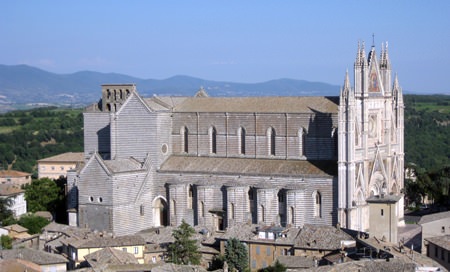A third of the world’s wine comes from Italy. To be more precise, the country produces about 50 million hectoliters of the stuff every year. And if the mention of hectoliters makes your mind go numb, it works out at a staggering 1,320,860,261 gallons. The Etruscans and the Greek settlers produced wine – of a sort- in Italy long before the Romans got started, with the result that Italy has some of the oldest wine-producing regions in the world. Grapes are grown almost everywhere and there are more than one million vineyards up and down the length of the boot-shaped country.
Partly for this reason, Italian wines can be a bit of a minefield for the wine beginner. There are literally hundreds of different Italian wines and selecting a decent bottle can be a bit daunting. For a start, the dominant name on the label could be that of the grape variety (like Lambrusco); it could be the name of the place the wine comes from (like Bardolino) or it could be the name of a broad wine region (like Chianti). It could also be the name of the producer (like Lungarotti). Just to confuse things further, Prosecco is both the name of the wine and the grape from which it comes.
 The Cathedral at Orvieto.
The Cathedral at Orvieto.
Ah yes, the grapes. Although you can find Italian versions of familiar international grape varietals like Chardonnay and Merlot, it’s often the country’s local vines that offer the most characteristic flavours. They grow over five hundred different grape varieties in Italy and some of them are found nowhere else in the world. They sometimes have rather poetic names too. With a loud Italian accent and theatrical gestures, try pronouncing the names Corvina, Molinara, Rondinella and Negrara. You see, you sound like an Italian already. Incidentally, all those four grapes are usually used to make Valpolicella, that lovely fragrant red wine from Italy’s North-East.
Italian wines have come a long way from straw-covered Chianti flasks and the old “spag and vino” image of a simple rustic glugger. But be careful, because there are still a few dodgy Italian wines around, especially some of those that come in huge bottles. Stay with reliable wine outlets or well-known names and you’ll usually be safe.
Cecchi Orviento Classico DOC, 2012 (white) Italy (Bt. 499 @ Villa)
Right then, let’s get this label sorted out. Sit up and listen, and feel free to make notes. Orvieto is not a grape variety, but the name of an attractive town in south-western Umbria, almost slap bang in the middle of Italy. Orvieto is almost always known for its white wines and this one is made by a company called Cecchi (CHECK-ee) a well-known family wine maker which has been producing wine in the region since 1893. The word “Classico” is used exclusively for white wines from the traditional and supposedly superior vineyards on the hills around Orvieto town itself. DOC stands for Denominazione di origine controllata (“Controlled designation of origin”) and it’s basically a quality assurance label. DOC wines are a couple of notches up from Vino Da Tavola, which is invariably basic plonk.
This is a very pale straw-yellow with just the slightest hint of green. There’s a very attractive delicate floral aroma of melon and pineapple, with a faint hint of orange peel in the background. The wine is dry and soft on the palate with a pleasing cut of citric acidity and a crisp, minerally finish. There’s fresh fruit too but rather reserved, in typical Orvieto style.
Actually, this is what I enjoy about Orvieto – it’s a light summery sort of wine that’s perfect with food because it doesn’t get in the way. It’s is a quintessential Italian white, well-balanced, very light, crisp and dry. Italian wine law allows for a fair amount of flexibility in the grapes used for Orvieto. The label doesn’t reveal the grape varieties used, but you can be sure that there’s between 40%-60% Trebbiano in the blend along with three lesser-known (and slightly less poetically-named) local varieties, Grechetto, Drupeggio and Procanico. To preserve the freshness of the wine, it was fermented in temperature-controlled stainless steel tanks and the gentle touch of acidity would make it a perfect apéritif. It’s just 12% alcohol by volume and would work well with fish, white meat and poultry. The makers suggest you drink it at 12°-14°C but a few degrees lower wouldn’t do it any harm.
Due Tigli Merlot-Cabernet, Rubicone IGT, (red) Italy (Bt. 339 @ Villa)
Due Tigli is the brand name; Merlot and Cabernet Sauvignon are of course the grapes, and Rubicone is the name of the IGT (Indicazione Geografica Tipica) which lies in the huge Emilia-Romagna region of central Italy. The name comes from the Rubicon River, crossed by Julius Caesar and his troops at the start of the Great Roman Civil War and still remembered in an everyday English expression which means passing the point of no return. Sadly, despite its romantic associations, the river has become one of the most polluted in the region.
Due Tigli (it means “Two Lime Trees”) is one of the brands managed by the Cevico Group Consortium which was established in 1963 and has since become one of the most important wine-making companies in Italy, known especially for its boxed wines.
This wine is an intense red and although it’s blended from Merlot and Cabernet Sauvignon, the traditional ingredients of Bordeaux, don’t expect it to taste like one. It doesn’t even smell like one, and quite honestly I’d be a bit disappointed if it did. The Merlot dominates, with its woody, slightly earthy and herbaceous aromas. There’s an attractive bite to the taste yet it’s medium-bodied, with dry and delicate fruit. There’s quite a longish dry, fruity finish too. After fermentation, the wine was aged in tanks for five months which gives it a pleasantly rounded quality. But honestly, this is really a simple, straightforward wine with no frills. At a low and very welcome 11.5% alcohol content, it’s an attractive light-hearted wine that you’d find on the table of any half-decent Italian trattoria.
I rather enjoyed it on its own because it is so light and undemanding but as you may know, Italian wines are nearly always made for food. This would have made a perfect partner for the spicy Tagliatelle Carbonara that I made last night and I really should have tried it with that. But I didn’t, which just goes to show that even in this country, the Law of Sod sometimes prevails.




